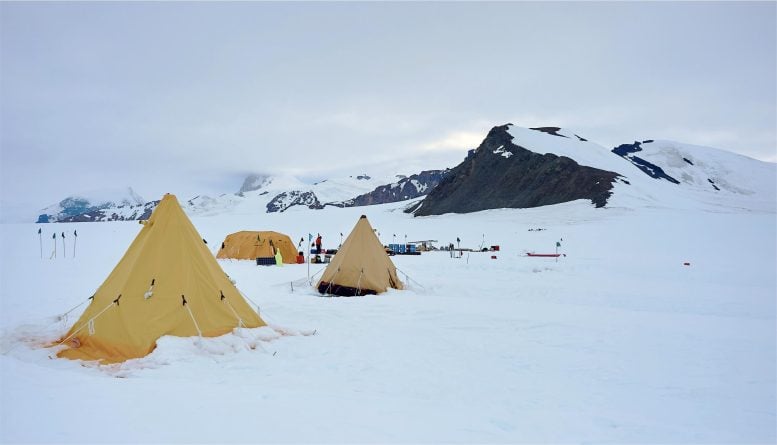
The field camp on Thwaites glacier where the team were based for drilling. Credit: Greg Balco (Berkeley Geochronology Center)
Researchers from the International Thwaites Glacier Collaboration found that the West Antarctic Ice Sheet had been thinner in the past and had regrown, suggesting that glacial retreat could be reversed. The study used rock samples to show that ice near Thwaites Glacier was at least 35 meters thinner in the last 5000 years and took a minimum of 3000 years to reach its current size. However, this recovery timeframe poses concerns given the expected impact of sea level rise due to imminent climate change.
The West Antarctic Ice Sheet is shrinking, with many glaciers across the region retreating and melting at an alarming rate. However, this was not always the case according to new research published last month in The Cryosphere. A team of scientists from the International Thwaites Glacier Collaboration (ITGC), including two researchers from the British Antarctic Survey (BAS), discovered that the ice sheet near Thwaites Glacier was thinner in the last few thousand years than it is today. This unexpected find shows that glaciers in the region were able to regrow following earlier shrinkage.
Sea level rise is already putting millions of people in low-lying coastal communities around the world at risk from flooding. The contribution from melting Antarctic ice is currently the greatest source of uncertainty in predictions of how much and how quickly the sea level will rise in the coming decades and centuries. Together with its immediate neighbor, Thwaites Glacier currently dominates the Antarctic contribution to sea level rise. To understand how this important glacier will respond to the climate changes expected in the coming century, scientists need to know how it behaves under a wide range of climatic conditions and over long timescales. Since satellite observations only go back a few decades in time, we need to look at the geological record to find this information.
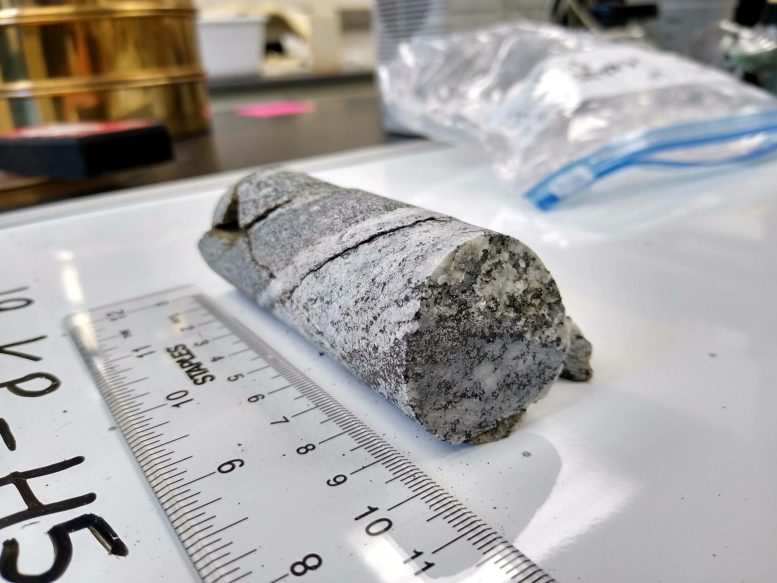
The rock cores were taken back to the lab from Thwaites for analysis. Credit: Keir Nichols (Imperial College London)
Jonathan Adams, co-author and PhD student at BAS, says:
“By studying the history of glaciers like Thwaites, we can gain valuable insight into how the Antarctic Ice Sheet may evolve in future. Records of ice sheet change from rocks that are presently exposed above the ice sheet surface end around 5000 years ago, so to find out what happened since then, we need to study rock presently buried beneath the ice sheet.”
Using drills specially designed to cut through both ice and the underlying rock, the team recovered rock samples from deep beneath the ice sheet next to Thwaites Glacier. They then measured, in those rock samples, specific atoms that are made when rocks are exposed at the surface of the Earth to radiation coming from outer space. If ice covers those rocks, these particular atoms are no longer made. Their presence can therefore reveal periods in the past when the ice sheet was smaller than the present.
Keir Nichols, a glacial geologist from Imperial College London and a lead author of the study, says:
“This was a huge team effort: several of us spent weeks away from home doing fieldwork in an extremely remote part of Antarctica, whilst others endured literally thousands of hours in the lab analyzing the rocks we collected. The atoms we measured exist only in tiny amounts in these rocks, so we were pushing right to the limit of what is currently possible and there was no guarantee it would work. We are excited that this is the first study to reveal the recent history of an ice sheet using bedrock collected from directly beneath it.”
The team discovered that the rocks they collected were not always covered by ice. Their measurements showed that, during the past 5000 years, ice near Thwaites Glacier was at least 35 meters thinner than it is now. Furthermore, their models demonstrated that its growth since then – making the ice sheet the size it is today – took at least 3000 years.
This discovery reveals that ice sheet retreat in the Thwaites Glacier region can be reversed. The challenge for scientists now is to understand the conditions required to make that possible.
Joanne Johnson, a geologist at BAS and co-author of the study, says:
“On the face of it, these results seem like good news – Thwaites Glacier was able to regrow from a smaller configuration in the geologically-recent past. However, our study shows that this recovery took more than 3000 years, in a climate that was likely not as warm as what we expect for the coming centuries. If we want to avoid the impacts of sea level rise on our world that will result from continued retreat of the West Antarctic Ice Sheet, that timescale is far longer than we can afford to wait.”
Reference: “Reversible ice sheet thinning in the Amundsen Sea Embayment during the Late Holocene” by Greg Balco, Nathan Brown, Keir Nichols, Ryan A. Venturelli, Jonathan Adams, Scott Braddock, Seth Campbell, Brent Goehring, Joanne S. Johnson, Dylan H. Rood, Klaus Wilcken, Brenda Hall and John Woodward, 28 April 2023, The Cryosphere.
DOI: 10.5194/tc-17-1787-2023

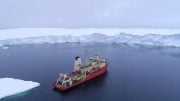


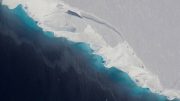
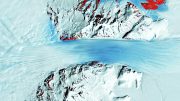
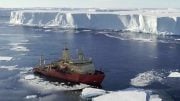
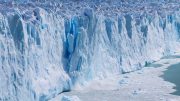

This is terrifying. Is there any way we could make people eat bugs or blot out the sun, to stop this cycle of glacier melt and growth? This million-year-old Thwaites glacier is nicknamed the Doomsday Glacier in the media, because it’s melting, but apparently it was dramatically smaller for the first people whose names we know in recorded history. It’s been growing since. How do we stop the threat of climate change before this unstoppable glacier takes over our frozen world?
Even for an obvious troll handle comment, that is not even there. What “frozen world”!?
The problem is that humanity is making the world warming fast, in a way that “is already putting millions of people in low-lying coastal communities around the world at risk from flooding.”
Didn’t you read the article? First sentence, “the West Antarctic Ice Sheet had been thinner in the past and had regrown…at least 35 meters thinner in the last 5000 years and took a minimum of 3000 years to reach its current size”. So the Doomsday Glacier was smaller, and grew more than thirty five meters thicker in the past three thousand years. With this rapid and dramatic glacial growth, I was parodying the ‘Doomsday’ panic about something obviously cyclical.
You might want to consider using a pseudonym online, as there aren’t many Torbjörn Larssons, if that is your name. Especially when replying to everyone who comments, insulting them, and making claims without evidence, which seems more troll-like to me.
“…, suggesting that glacial retreat COULD be reversed.”
I don’t have words to adequately and deservedly ridicule that statement. Of course glacial retreat can be reversed, and almost certainly will be! Over roughly the last 2 my, the Pleistocene epoch in North America has experienced at least four glacial stages (Not counting the Little Ice Age during the Holocene epoch, when alpine glaciers advanced significantly.) interspersed with warm interglacials, which most glaciologists assume we are currently in.
Evidence from drilling in Greenland shows that during the Eemian interglacial (aka Sangamonian stage) the ice melted back to bare rock and developed soil in which plants grew. ALL of the recent interglacial stages (except the current one) have been followed by glacial stages. Previous interglacials have been warmer than the Earth currently is. What is to stop another glacial stage? “Be careful what you wish for. You may get it.”
This is discussing reversal of man made global warming, hence the 3 kyrs is long, see the article.
And on your deflection attempt of that problem, FWIW there are observations that implies there will be no glacial stage, the world is now warming too much. Maybe you should consider what we should do instead of trying to defend your personal feelings from what the observations tell us.
Thanks for running through the geological epochs. I could only make fun of the article. Readers may not realize it’s cyclical, that say, New York was under ice a mile thick, or at times there weren’t glaciers. Not everybody has to know geology, but we’re being manipulated geologically.
Why do they keep doing articles like this? The geologists have the ice cores right there. They can see the cycles written in it. They know the epochs. Is it purely just for funding? Is it a new generation of silly geologists? Maybe the PR departments writing these things? All of scitechdaily’s articles except this one call it the “Doomsday Glacier”. I’m concerned about a changing climate, because it’s a true inconvenience, but we don’t have to check our brains with our coats at the door. The only way to prevent the glacier from growing again is by making the Earth crash into the Sun, and if that was possible I’d have already done it halfway through some of these articles.
“Why do they keep doing articles like this?”
I wish I knew. I suspect that part of the problem is that academics in general, and especially new hires, are under pressure to ‘publish or perish.’ They probably find it easier to get published if they get on the bandwagon by supporting the idea of a threat from anthropogenic global warming. Something that is claimed to be an existential threat to the world has priority over a topic like the mating habits of fleas, and if a commonly accepted paradigm, such as anthropogenic global warming, is supported, the only opposition is from skeptics who have difficulty getting published. So, if the newly hired, none-tenured assistant professors want to get published, avoiding rocking the boat is a good approach — although it isn’t good science.
The reason why these articles appears – at a rate of 99.9999 % of climate scaience articles – is because scientists report the science and the science tell us man made global warming is here and is a risky problem.
Whether or not some people in their personal opinion can disregard real risks, scientists and most people cannot.
For anyone reading, I mean “climate scaience” articles with fundamental errors or absurd claims. Clyde Spencer gave an excellent example of how this article is silly; of course the glacier will grow eventually and we can’t even stop it. If a study offers a dire climate change warning, and isn’t riddled with absurdity or errors, that’s useful.
Oh, and this article isn’t a report from scientists. It’s a press release written by the public relations press department at the BAS. You can read it on SVRTechs, ICViral, Tech Explorist, Knowledia, even El Paco. PHD Comics did an excellent analysis of The Science News Cycle, check it out.
Payments can be done by phone, mail, or online at the official PayByPlateMA website. The invoice contains payment instructions along with the necessary reference number. Visit PaybyPlateMa